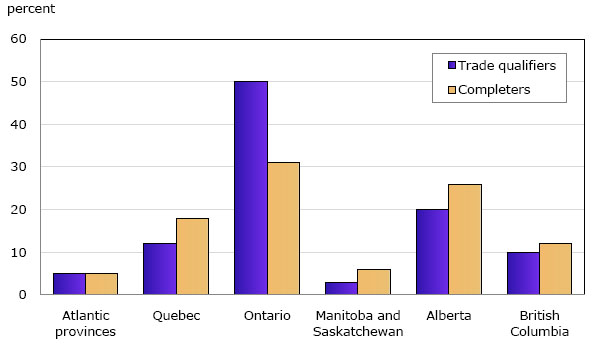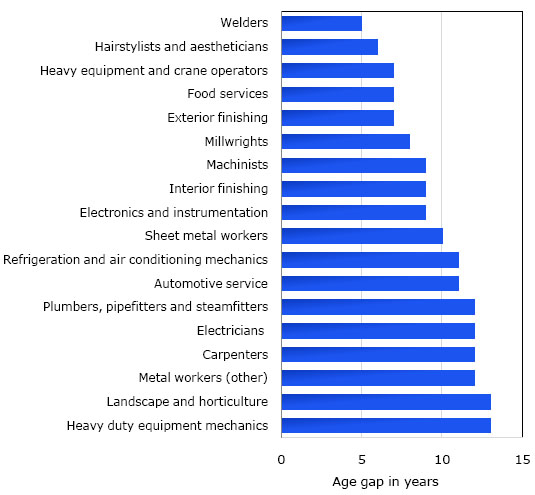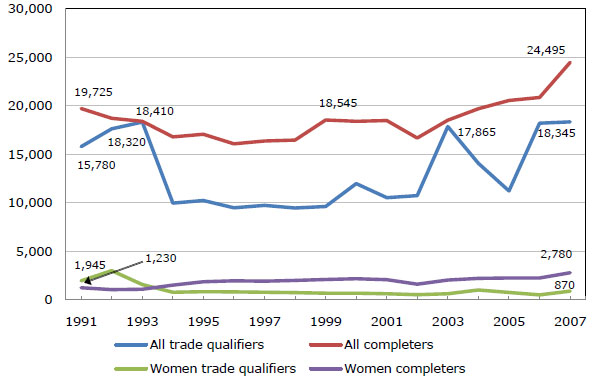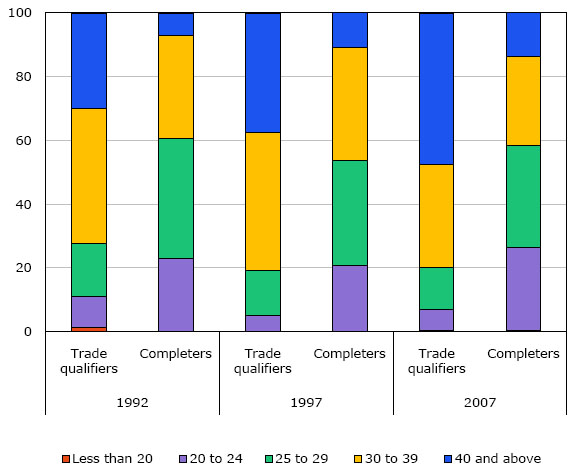Trade Qualifiers in the Skilled Trades in Canada: An Overview
Archived Content
Information identified as archived is provided for reference, research or recordkeeping purposes. It is not subject to the Government of Canada Web Standards and has not been altered or updated since it was archived. Please "contact us" to request a format other than those available.
Louise Desjardins
Tourism and the Centre for Education Statistics Division
Statistics Canada
A profile of trade qualifiers
Certification of skilled trades workers over time
Conclusion
Despite job losses caused by the economic downturn, many Canadian employers continue to have difficulties filling positions because of a shortage of workers with skills corresponding to their needs. According to a survey conducted in 2009, nearly one-quarter (24%) of Canadian employers stated that they had not managed to find "the right talent to fill jobs." Of the 10 jobs most difficult to fill, skilled trades came first, ahead of engineers, teachers and nurses.1
In Canada, apprenticeship training is the main method used to train workers in the skilled trades. However, it is not always necessary to have completed an apprenticeship program or to have been a registered apprentice to be granted a certificate of qualification and to work in a skilled trade. Some people can obtain a certificate of qualification as a "trade qualifier." This term refers to any person who has not completed an apprenticeship program but who has acquired enough practical work experience to write the examination to obtain the certificate of qualification (or certificate of competence) issued by the provincial or territorial authorities responsible for certifying trades workers. Generally, these persons are already trades workers active in various work environments.
This article draws a profile of trade qualifiers, using data from the Registered Apprenticeship Information System (RAIS), 2 comparing them to completers of apprenticeship programs.
A profile of trade qualifiers
In 2007, 18,341 persons obtained a certificate of qualification as trade qualifiers in a skilled trade in Canada. The vast majority of them (94%) had never undertaken an apprenticeship program before obtaining their certificate. The others had completed an apprenticeship program in another trade (2%) or had discontinued their training (4%). This compares to 24,400 persons completing an apprenticeship program in 2007. In other words, in that year, more than two certificates of qualification in five (43%) were issued to individuals who had never undertaken an apprenticeship training program, that is, to trade qualifiers.
The four most populous Canadian provinces granted 90% of certificates of qualification to trade qualifiers in 2007. Half of them obtained their certificate in Ontario and 20%, in Alberta. Quebec issued 12% of all certificates of qualification in Canada, followed by British Columbia (10%) (Chart 1).
As for completers of apprenticeship programs, the proportions in Ontario and Alberta were similar (30% and 26%, respectively), while 18% completed their training in Quebec and 12% did so in British Columbia. Only Ontario granted a larger number of certificates to trade qualifiers (9,192) than to completers (7,547), mainly owing to the construction craft workers trade. Nearly 3,000 Ontarians were qualifiers in this trade in 2007, while there were only 35 completers in the same trade in Canada as a whole.
Chart 1
Trade qualifiers and completers, by province, 2007

Note: Percentage may not sum to 100 because of rounding.
Source: Statistics Canada, Registered Apprenticeship Information System, 2007
Three skilled trades workers in ten obtained a certificate of qualification as a trade qualifier in two major trade groups: construction craft workers (16.2%) and electricians (14%). Other trades which had high proportions of trade qualifiers were: trades related to automotive service (9.3%), welders (8.4%), oil and gas well drillers and related workers (7.5%), heavy equipment and crane operators (7.5%) and landscape and horticulture technicians and specialists (6.4%). Similarly, electricians (18.8%), trades related to automotive service (13.9%) and carpenters (10.1%) were also highly represented among the 2007 completers of apprenticeship programs (Table 1).
| Trade | Trade qualifiers | Completers |
|---|---|---|
| percent | ||
| Construction craft workers | 16.2 | 0.1 |
| Electricians | 14.0 | 18.8 |
| Automotive service | 9.3 | 13.9 |
| Welders | 8.4 | 4.9 |
| Oil and gas well drillers, servicers, testers and related workers | 7.5 | 0.0 |
| Heavy equipment and crane operators including drillers | 7.5 | 4.1 |
| Landscape and horticulture technicians and specialists | 6.4 | 0.4 |
| Plumbers, pipefitters and steamfitters | 5.4 | 10.2 |
| Carpenters | 4.5 | 10.1 |
| Millwrights | 3.8 | 4.1 |
| Hairstylists and aestheticians | 3.8 | 8.5 |
| Heavy duty equipment mechanics | 2.5 | 3.4 |
| Food services | 2.2 | 2.4 |
| Refrigeration and air conditioning mechanics | 2.1 | 2.2 |
| Metal workers (other) | 1.5 | 2.4 |
| Machinists | 1.4 | 2.8 |
| Interior finishing | 1.0 | 2.9 |
| Electronics and instrumentation | 1.0 | 1.3 |
| Other | 0.7 | 1.7 |
| Exterior finishing | 0.6 | 2.6 |
| Sheet metal workers | 0.4 | 2.1 |
| Early childhood educators and assistants | 0.0 | 1.1 |
| Total | 100.2 | 100.0 |
|
Note: Percentage may not sum to 100 because of rounding. Note: Data are shown in descending order of the proportions of trade qualifiers. Source: Statistics Canada, Registered Apprenticeship Information System. |
||
Women accounted for only 5% of trade qualifiers, half their share of completers of apprenticeship programs (at approximately 11%). Women also accounted for 84% of trade qualifiers in the hairstylist/aesthetician trades, and 27% of persons who obtained a certificate of qualification in food services, which include the cook, butcher and baker trades.
More than eight trade qualifiers in ten (83%) received a certificate of qualification in a trade covered by the Red Seal Interprovincial Standards Program, a proportion eight percentage points lower than for completers (91%). Proportionally more women (93%) than men (83%) were awarded a certificate in a trade covered by the Red Seal program, owing to their being highly represented among hairstylists, a Red Seal trade. Conversely, proportionally more male apprentices completed an apprenticeship program ( i.e., they were completers) in a Red Seal trade (91% compared to 85%). It should be noted that obtaining a certificate in a trade covered by the Red Seal Interprovincial Standards Program does not necessarily mean that a Red Seal endorsement is affixed to the certificate of qualification. The only way to obtain a Red Seal endorsement is to pass the interprovincial Red Seal examination administered by the provincial or territorial bodies that govern apprenticeship programs and the issuing of certificates of qualification. In fact, about two out of five (42%) trade qualifiers in a Red Seal trade and almost three completers in five (59%) of a Red Seal apprenticeship program actually received such an endorsement in 2007.3
With a median age of 39, trade qualifiers were considerably older than completers of an apprenticeship program, whose median age was 28. In eight trades out of eighteen, the age gap between trade qualifiers and completers was at least 10 years. In contrast, the age gaps were smaller for welders (5 years), hairstylists and estheticians (6 years), heavy equipment and crane operators (7 years), the food service trades (7 years) and the exterior finishing trades (7 years), with the latter category including masons, roofers and glaziers.
Chart 2
Age gap between trade qualifiers and completers, by trade, 2007

Source: Statistics Canada, Registered Apprenticeship Information System, 2007
Furthermore, the 40 and over age group had the largest proportion of trade qualifiers (46%), while the 25 to 29 age group had the largest proportion of completers (32%).
Certification of skilled trades workers over time
Chart 3 shows the large fluctuations in the number of trade qualifiers over the years. From 1991 to 1993, the number of trade qualifiers increased by 16%, rising from 15,780 to 18,320. However, in the next year, 1994, only 9,950 certificates of qualification were awarded to trade qualifiers, a decrease of 45%. During the next nine years and until 2003, the number of trade qualifiers never exceeded 12,000; it was only at the end of 2003 that the number of trade qualifiers reached a level similar to 1993, namely 17,865. Finally, between 2003 and 2007, the number grew by only 2% to reach 18,345.
There is no obvious relationship between these fluctuations and how the labour market evolved during this period. Given that employment was up 2.1% in 1994 compared to 1993, it seems unlikely that the sizable drop in the number of certificates issued to trade qualifiers in 1994 was related to limited job prospects. Also, the meagre increase between 2006 and 2007 in the number of trade qualifiers receiving a certificate corresponded to a 2.3% increase in employment.4 It may be that in a period of employment growth, trades workers find it easier to get work and are therefore less inclined to seek a certificate of qualification.
Meanwhile, the number of completers followed a somewhat different trend from that of trade qualifiers. Although the number of completers declined somewhat after 1993 (by nearly 12% between 1993 and 1998), that number began to recover in 1999, when it reached 18,545. In the following years (with the exception of 2002), the number of completers either remained at the same level or increased annually. It registered its strongest increase between 2006 and 2007, rising from 20,855 to 24,495, a gain of 17% (Chart 3).
Chart 3
Number of trade qualifiers and completers, 1991 to 2007

Note: Figures are rounded to the nearest 5.
Source: Statistics Canada, Registered Apprenticeship Information System and Table 477-0052 – Registered apprenticeship training, completions by major trade groups and sex, annual (number), CANSIM (database).
www.statcan.gc.ca/cansim (website accessed on July 5, 2010).
As noted above, in 2007, women accounted for only about 5% of persons receiving a certificate of qualification as a trade qualifier. This proportion is one of the lowest in the 17 years on record, whereas the proportion of women in the early 1990s were two to three times higher: 17% in 1992, 12% in 1991 and 9% in 1993. This situation is almost entirely due to the fact that during these three years, the majority of women who obtained their certificate of qualification as trade qualifiers did so in the hairstylist trade in Ontario. Indeed, these women accounted for more than eight female trade qualifiers in ten in 1991 and 1992 (88% and 82%, respectively), whereas the share of females who were trade qualifiers in the hairstylist trade fell to approximately 60% in 1993 and 1994. At the same time, the number of new female apprentices in hairstylist apprenticeship programs doubled between 1992 and 1994 in that province, increasing from 1,305 to 2,630. These trends reflect the consolidation of hairstylist apprenticeship programs in Ontario in 1993.
For female completers, the trend was reversed: the proportion of women increased over the years, rising from 6% in 1991 to 11% in 2007. As noted above, this growth reflects, in part, changes made to hairstylist apprenticeship programs in Ontario. It also is likely due to efforts to recruit more women into apprenticeship programs over the last decade. In fact, the proportion of apprenticeship program participants who were women more than doubled between 1993 and 2007 (rising from 5% to 10.6%).
As seen above, in 2007, nearly half (46%) of trade qualifiers were aged 40 and over, an increase of 9 percentage points compared to 1997 (at approximately 37%) and at least 16 percentage points higher than in 1992. In the meantime, at 32%, the proportion of trade qualifiers in the 30 to 39 age group was 11 percentage points lower in 2007 than in 1992 (42%) and 1997 (43%).
In contrast, close to one-third of persons completing an apprenticeship program in 2007 were aged 25 to 29. Although the proportion of completers in this age group decreased by six percentage points compared to 1992, two age groups saw higher proportions than in the past: 20 to 24 year-olds, at 26% in 2007 compared to 23% in 1992 and the 40 and over age group, which had nearly twice the proportion in 2007 as that recorded in 1992 (at 13% and 7%, respectively) (Chart 4).
Chart 4
Distribution of trade qualifiers and completers by age group, 1992, 1997 and 2007

Note: Because of the large number of cases where age was not reported in 1991, the 1992 data are used as the starting year.
Source: Statistics Canada, Registered Apprenticeship Information System
Thus, trade qualifiers in 2007 were older than their counterparts in earlier years, while for completers, the youngest and oldest age groups (20 to 24 years old and 40 and over) saw their proportions increase, while the share of 25 to 39 year-olds decreased.
Conclusion
While apprenticeship training is the main method used to train workers in the skilled trades, the analysis reported here shows that slightly more than 40% of certificates of qualification issued in 2007 went to individuals who had never undertaken an apprenticeship training program, that is, to trade qualifiers. About 30% of these trade qualifiers were found in two trades in 2007 – construction craft workers and electricians.
It is not by chance that there was a 10-year gap between the median age of trade qualifiers and that of completers of apprenticeship programs in 2007. To successfully pass the provincial or territorial examination for their trade, trade qualifiers must have sufficient work experience and knowledge in that trade.
As noted earlier, the proportion of trade qualifiers aged 40 and over in 2007 (46%) was up considerably compared to 1997 (37%) and 1992 (30%), although the absolute number of trade qualifiers grew by only 4% between 1992 and 2007. The growing number of certificates awarded to individuals aged 40 and over could be an effect of the general aging of the labour force in Canada combined with the competitive edge that the certificate of qualification provides in the new knowledge economy.
The findings reported here do raise some interesting questions, one of which is what motivates individuals to challenge the examination and seek the qualification of journeyperson. The Registered Apprenticeship Information System does not contain such information, but analysis using other databases may shed some light on this question.
Notes
-
2009 Talent Shortage Survey Results. Milwaukee, Manpower Inc., 13 p. This document presents the results of a 2009 survey of 39,000 employers in 33 countries and territories, including Canada. The results are presented for each country.
-
The Quebec data collected by the Registered Apprenticeship Information System (RAIS) come from two sources: the Commission de la construction du Québec and Emploi-Québec. As regards the data from Emploi-Québec, only information on regulated trades was provided. Also, the RAIS has no information on programs in the automotive sector. Consequently, there is undercoverage of the apprentices and trade qualifiers in that province.
-
It should be noted that the 2007 RAIS considered Construction Craft Worker and Rig Technician as Red Seal trades in 2007. While this is true, those trades were only designated at the very end of 2006. As a result, apprentices in those two trades were not able to write the Red Seal exam in 2007 since the exams for those two trades had not yet been developed. Excluding those two trades, the percentage of trade qualifiers who obtained a Red Seal endorsement increased from 42% to 60%, making trade qualifiers as likely to obtain a Red Seal endorsement as apprenticeship completers.
-
Statistics Canada. Table 282-0002: Labour force survey estimates (LFS), by sex and detailed age group, annual, CANSIM (Database), http://cansim2.statcan.gc.ca (website accessed on July 27, 2010).
- Date modified:
